Organizational Behavior Essay
VerifiedAdded on 2019/10/31
|8
|1899
|189
Essay
AI Summary
This essay examines the relationship between emotional labor and employee productivity. It explores the concept of emotional labor, differentiating between deep acting and surface acting. The essay highlights how both positive and negative workplace environments influence employee mood and productivity. It emphasizes the importance of a positive work culture, proper motivation, and recognition in enhancing employee performance. The essay also discusses the role of personal resources in managing emotions and meeting professional requirements. Finally, it concludes that a supportive and motivating work environment is crucial for maximizing employee productivity and overall organizational success. The essay cites several research articles to support its arguments.
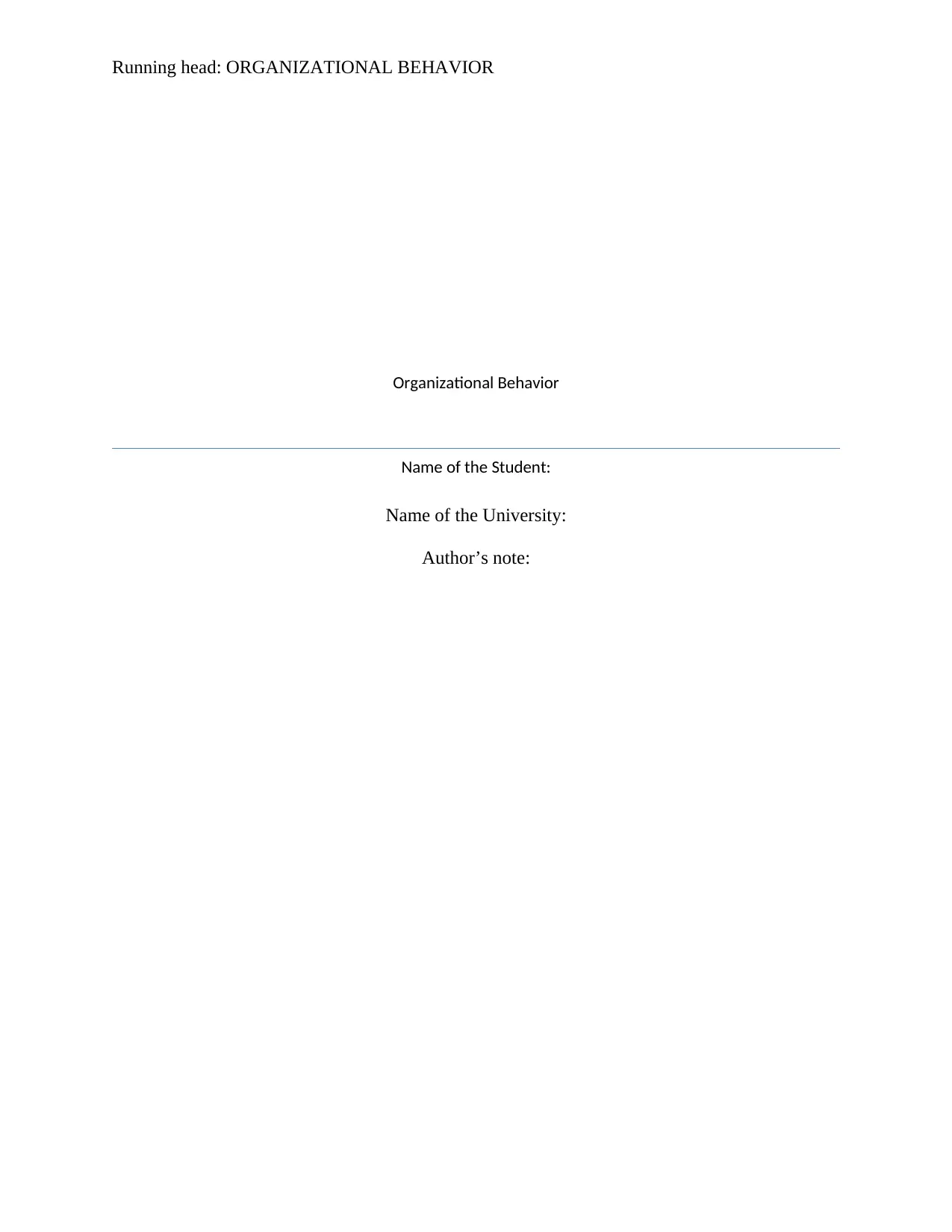
Running head: ORGANIZATIONAL BEHAVIOR
Organizational Behavior
Name of the Student:
Name of the University:
Author’s note:
Organizational Behavior
Name of the Student:
Name of the University:
Author’s note:
Paraphrase This Document
Need a fresh take? Get an instant paraphrase of this document with our AI Paraphraser
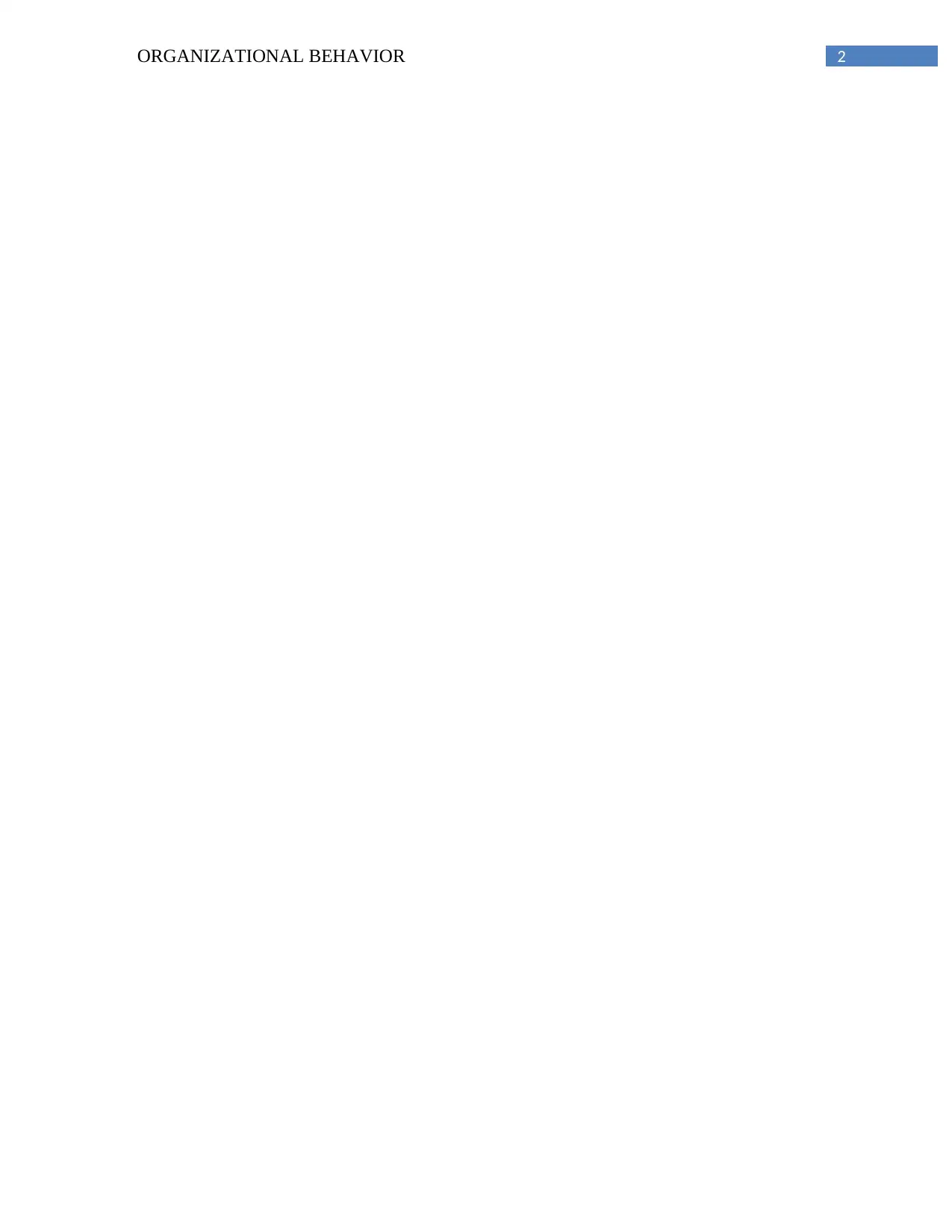
2ORGANIZATIONAL BEHAVIOR
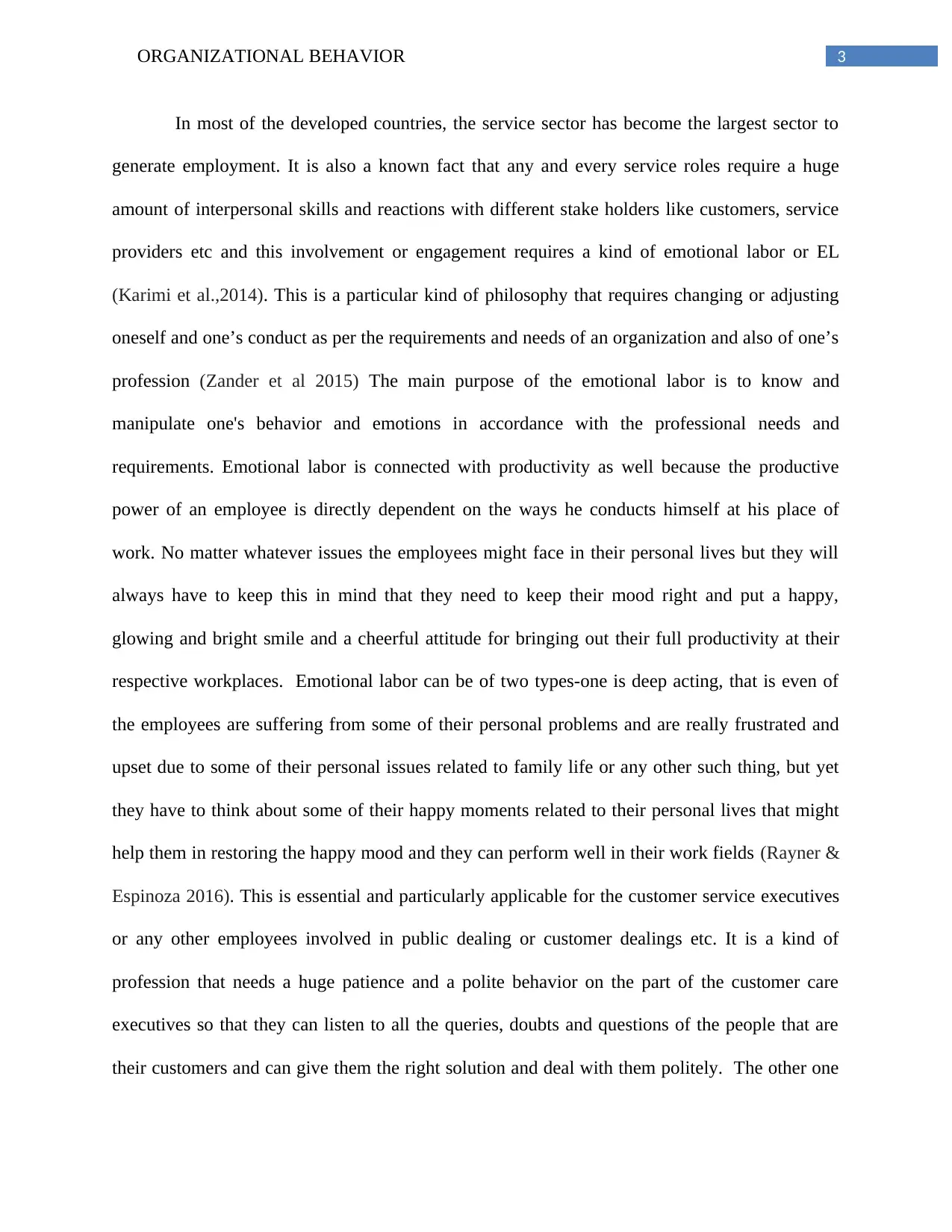
3ORGANIZATIONAL BEHAVIOR
In most of the developed countries, the service sector has become the largest sector to
generate employment. It is also a known fact that any and every service roles require a huge
amount of interpersonal skills and reactions with different stake holders like customers, service
providers etc and this involvement or engagement requires a kind of emotional labor or EL
(Karimi et al.,2014). This is a particular kind of philosophy that requires changing or adjusting
oneself and one’s conduct as per the requirements and needs of an organization and also of one’s
profession (Zander et al 2015) The main purpose of the emotional labor is to know and
manipulate one's behavior and emotions in accordance with the professional needs and
requirements. Emotional labor is connected with productivity as well because the productive
power of an employee is directly dependent on the ways he conducts himself at his place of
work. No matter whatever issues the employees might face in their personal lives but they will
always have to keep this in mind that they need to keep their mood right and put a happy,
glowing and bright smile and a cheerful attitude for bringing out their full productivity at their
respective workplaces. Emotional labor can be of two types-one is deep acting, that is even of
the employees are suffering from some of their personal problems and are really frustrated and
upset due to some of their personal issues related to family life or any other such thing, but yet
they have to think about some of their happy moments related to their personal lives that might
help them in restoring the happy mood and they can perform well in their work fields (Rayner &
Espinoza 2016). This is essential and particularly applicable for the customer service executives
or any other employees involved in public dealing or customer dealings etc. It is a kind of
profession that needs a huge patience and a polite behavior on the part of the customer care
executives so that they can listen to all the queries, doubts and questions of the people that are
their customers and can give them the right solution and deal with them politely. The other one
In most of the developed countries, the service sector has become the largest sector to
generate employment. It is also a known fact that any and every service roles require a huge
amount of interpersonal skills and reactions with different stake holders like customers, service
providers etc and this involvement or engagement requires a kind of emotional labor or EL
(Karimi et al.,2014). This is a particular kind of philosophy that requires changing or adjusting
oneself and one’s conduct as per the requirements and needs of an organization and also of one’s
profession (Zander et al 2015) The main purpose of the emotional labor is to know and
manipulate one's behavior and emotions in accordance with the professional needs and
requirements. Emotional labor is connected with productivity as well because the productive
power of an employee is directly dependent on the ways he conducts himself at his place of
work. No matter whatever issues the employees might face in their personal lives but they will
always have to keep this in mind that they need to keep their mood right and put a happy,
glowing and bright smile and a cheerful attitude for bringing out their full productivity at their
respective workplaces. Emotional labor can be of two types-one is deep acting, that is even of
the employees are suffering from some of their personal problems and are really frustrated and
upset due to some of their personal issues related to family life or any other such thing, but yet
they have to think about some of their happy moments related to their personal lives that might
help them in restoring the happy mood and they can perform well in their work fields (Rayner &
Espinoza 2016). This is essential and particularly applicable for the customer service executives
or any other employees involved in public dealing or customer dealings etc. It is a kind of
profession that needs a huge patience and a polite behavior on the part of the customer care
executives so that they can listen to all the queries, doubts and questions of the people that are
their customers and can give them the right solution and deal with them politely. The other one
⊘ This is a preview!⊘
Do you want full access?
Subscribe today to unlock all pages.

Trusted by 1+ million students worldwide
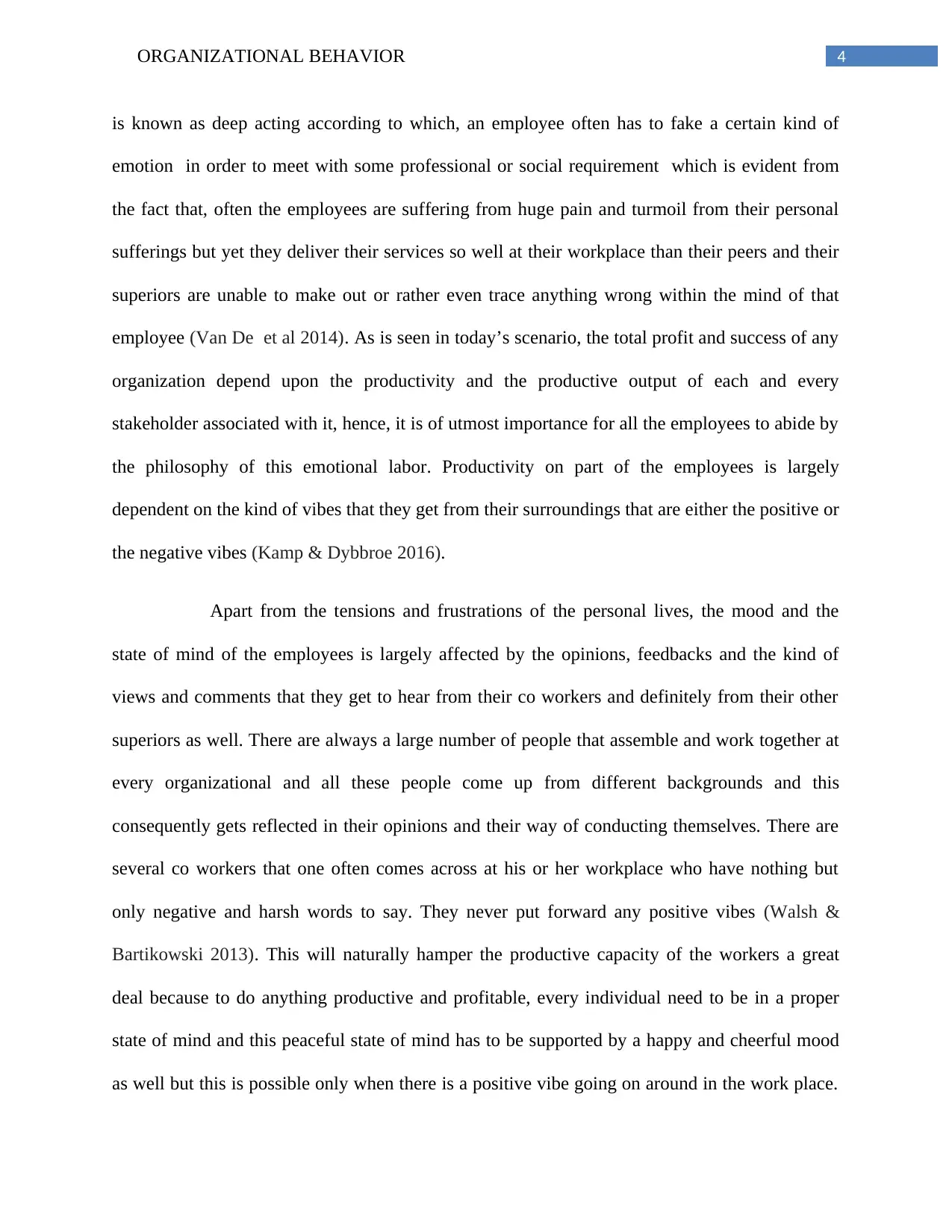
4ORGANIZATIONAL BEHAVIOR
is known as deep acting according to which, an employee often has to fake a certain kind of
emotion in order to meet with some professional or social requirement which is evident from
the fact that, often the employees are suffering from huge pain and turmoil from their personal
sufferings but yet they deliver their services so well at their workplace than their peers and their
superiors are unable to make out or rather even trace anything wrong within the mind of that
employee (Van De et al 2014). As is seen in today’s scenario, the total profit and success of any
organization depend upon the productivity and the productive output of each and every
stakeholder associated with it, hence, it is of utmost importance for all the employees to abide by
the philosophy of this emotional labor. Productivity on part of the employees is largely
dependent on the kind of vibes that they get from their surroundings that are either the positive or
the negative vibes (Kamp & Dybbroe 2016).
Apart from the tensions and frustrations of the personal lives, the mood and the
state of mind of the employees is largely affected by the opinions, feedbacks and the kind of
views and comments that they get to hear from their co workers and definitely from their other
superiors as well. There are always a large number of people that assemble and work together at
every organizational and all these people come up from different backgrounds and this
consequently gets reflected in their opinions and their way of conducting themselves. There are
several co workers that one often comes across at his or her workplace who have nothing but
only negative and harsh words to say. They never put forward any positive vibes (Walsh &
Bartikowski 2013). This will naturally hamper the productive capacity of the workers a great
deal because to do anything productive and profitable, every individual need to be in a proper
state of mind and this peaceful state of mind has to be supported by a happy and cheerful mood
as well but this is possible only when there is a positive vibe going on around in the work place.
is known as deep acting according to which, an employee often has to fake a certain kind of
emotion in order to meet with some professional or social requirement which is evident from
the fact that, often the employees are suffering from huge pain and turmoil from their personal
sufferings but yet they deliver their services so well at their workplace than their peers and their
superiors are unable to make out or rather even trace anything wrong within the mind of that
employee (Van De et al 2014). As is seen in today’s scenario, the total profit and success of any
organization depend upon the productivity and the productive output of each and every
stakeholder associated with it, hence, it is of utmost importance for all the employees to abide by
the philosophy of this emotional labor. Productivity on part of the employees is largely
dependent on the kind of vibes that they get from their surroundings that are either the positive or
the negative vibes (Kamp & Dybbroe 2016).
Apart from the tensions and frustrations of the personal lives, the mood and the
state of mind of the employees is largely affected by the opinions, feedbacks and the kind of
views and comments that they get to hear from their co workers and definitely from their other
superiors as well. There are always a large number of people that assemble and work together at
every organizational and all these people come up from different backgrounds and this
consequently gets reflected in their opinions and their way of conducting themselves. There are
several co workers that one often comes across at his or her workplace who have nothing but
only negative and harsh words to say. They never put forward any positive vibes (Walsh &
Bartikowski 2013). This will naturally hamper the productive capacity of the workers a great
deal because to do anything productive and profitable, every individual need to be in a proper
state of mind and this peaceful state of mind has to be supported by a happy and cheerful mood
as well but this is possible only when there is a positive vibe going on around in the work place.
Paraphrase This Document
Need a fresh take? Get an instant paraphrase of this document with our AI Paraphraser
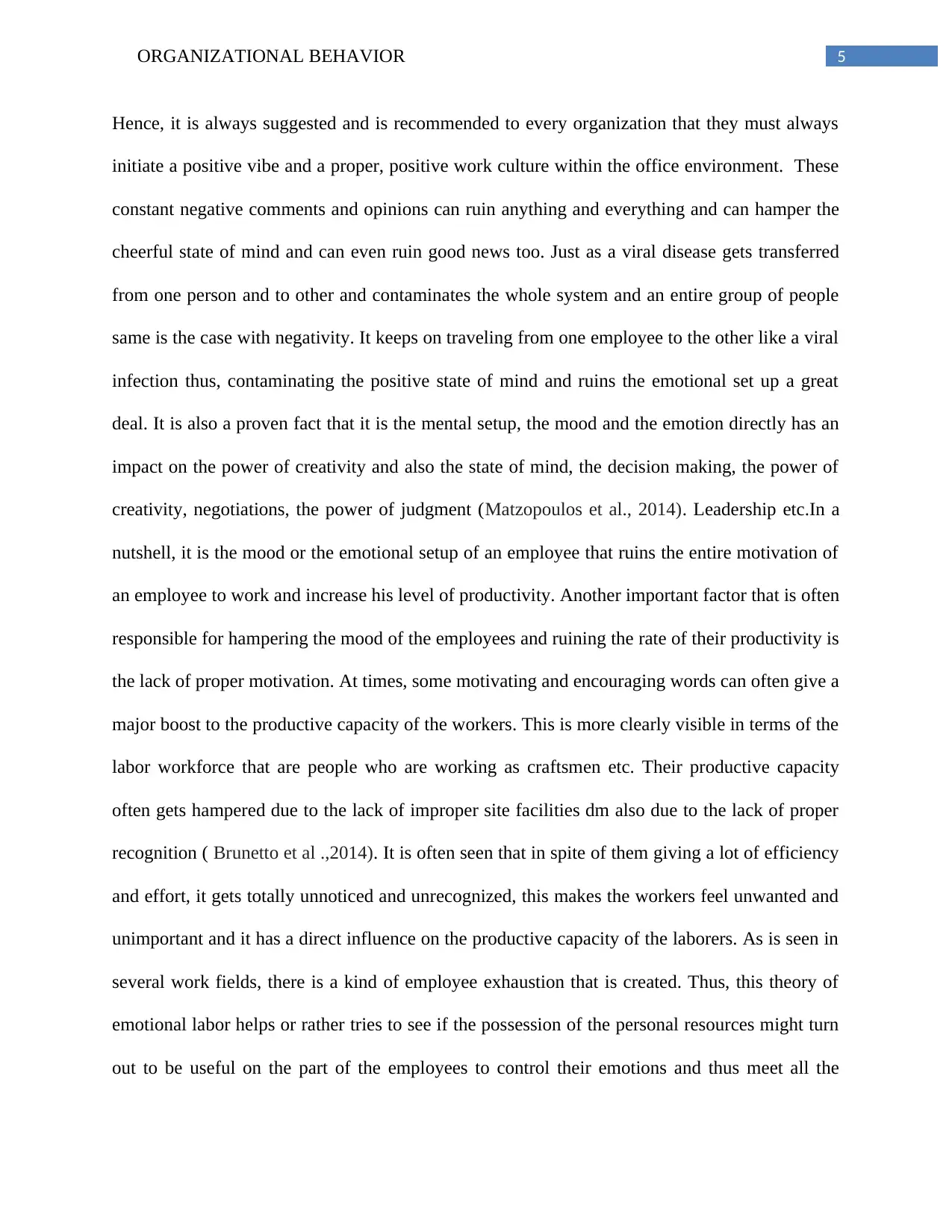
5ORGANIZATIONAL BEHAVIOR
Hence, it is always suggested and is recommended to every organization that they must always
initiate a positive vibe and a proper, positive work culture within the office environment. These
constant negative comments and opinions can ruin anything and everything and can hamper the
cheerful state of mind and can even ruin good news too. Just as a viral disease gets transferred
from one person and to other and contaminates the whole system and an entire group of people
same is the case with negativity. It keeps on traveling from one employee to the other like a viral
infection thus, contaminating the positive state of mind and ruins the emotional set up a great
deal. It is also a proven fact that it is the mental setup, the mood and the emotion directly has an
impact on the power of creativity and also the state of mind, the decision making, the power of
creativity, negotiations, the power of judgment (Matzopoulos et al., 2014). Leadership etc.In a
nutshell, it is the mood or the emotional setup of an employee that ruins the entire motivation of
an employee to work and increase his level of productivity. Another important factor that is often
responsible for hampering the mood of the employees and ruining the rate of their productivity is
the lack of proper motivation. At times, some motivating and encouraging words can often give a
major boost to the productive capacity of the workers. This is more clearly visible in terms of the
labor workforce that are people who are working as craftsmen etc. Their productive capacity
often gets hampered due to the lack of improper site facilities dm also due to the lack of proper
recognition ( Brunetto et al .,2014). It is often seen that in spite of them giving a lot of efficiency
and effort, it gets totally unnoticed and unrecognized, this makes the workers feel unwanted and
unimportant and it has a direct influence on the productive capacity of the laborers. As is seen in
several work fields, there is a kind of employee exhaustion that is created. Thus, this theory of
emotional labor helps or rather tries to see if the possession of the personal resources might turn
out to be useful on the part of the employees to control their emotions and thus meet all the
Hence, it is always suggested and is recommended to every organization that they must always
initiate a positive vibe and a proper, positive work culture within the office environment. These
constant negative comments and opinions can ruin anything and everything and can hamper the
cheerful state of mind and can even ruin good news too. Just as a viral disease gets transferred
from one person and to other and contaminates the whole system and an entire group of people
same is the case with negativity. It keeps on traveling from one employee to the other like a viral
infection thus, contaminating the positive state of mind and ruins the emotional set up a great
deal. It is also a proven fact that it is the mental setup, the mood and the emotion directly has an
impact on the power of creativity and also the state of mind, the decision making, the power of
creativity, negotiations, the power of judgment (Matzopoulos et al., 2014). Leadership etc.In a
nutshell, it is the mood or the emotional setup of an employee that ruins the entire motivation of
an employee to work and increase his level of productivity. Another important factor that is often
responsible for hampering the mood of the employees and ruining the rate of their productivity is
the lack of proper motivation. At times, some motivating and encouraging words can often give a
major boost to the productive capacity of the workers. This is more clearly visible in terms of the
labor workforce that are people who are working as craftsmen etc. Their productive capacity
often gets hampered due to the lack of improper site facilities dm also due to the lack of proper
recognition ( Brunetto et al .,2014). It is often seen that in spite of them giving a lot of efficiency
and effort, it gets totally unnoticed and unrecognized, this makes the workers feel unwanted and
unimportant and it has a direct influence on the productive capacity of the laborers. As is seen in
several work fields, there is a kind of employee exhaustion that is created. Thus, this theory of
emotional labor helps or rather tries to see if the possession of the personal resources might turn
out to be useful on the part of the employees to control their emotions and thus meet all the
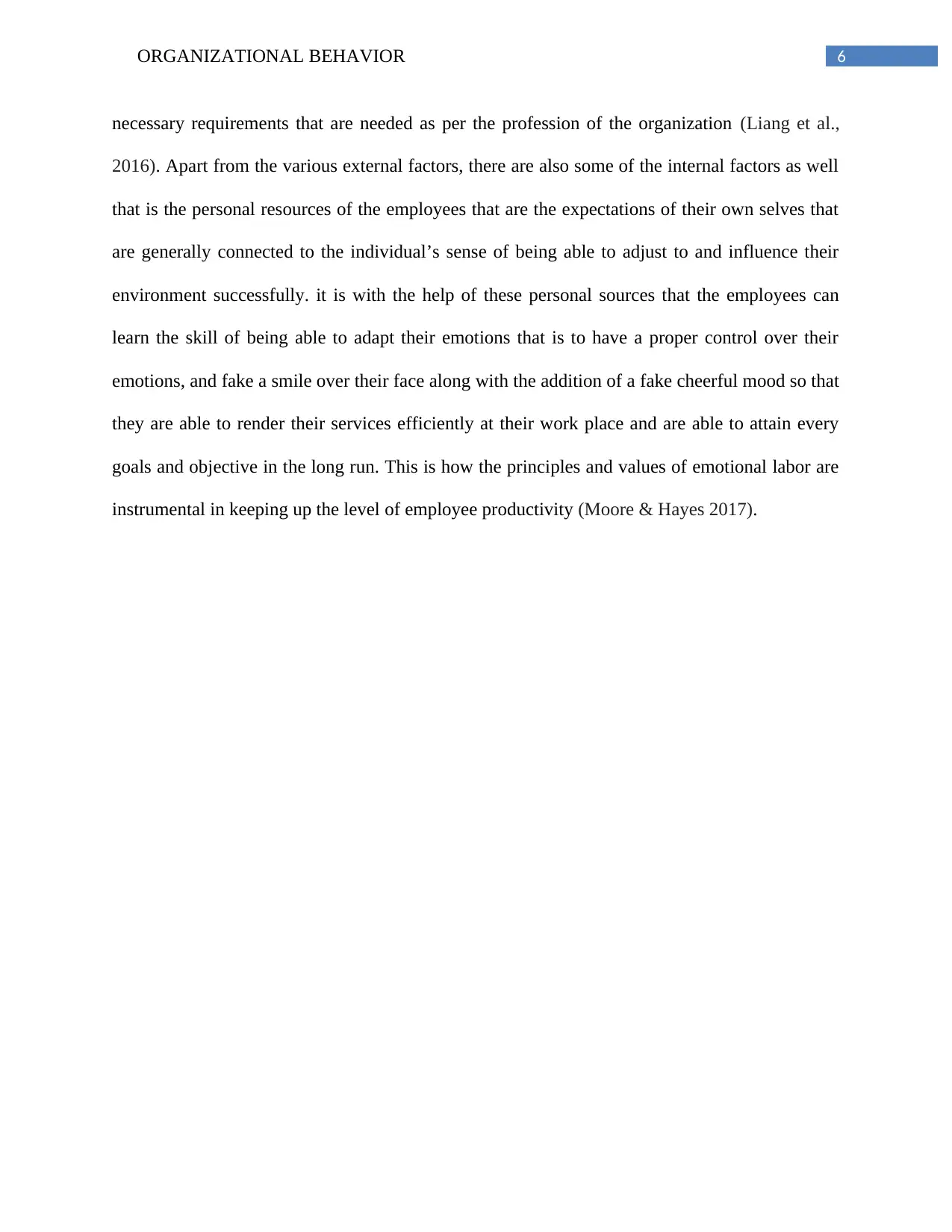
6ORGANIZATIONAL BEHAVIOR
necessary requirements that are needed as per the profession of the organization (Liang et al.,
2016). Apart from the various external factors, there are also some of the internal factors as well
that is the personal resources of the employees that are the expectations of their own selves that
are generally connected to the individual’s sense of being able to adjust to and influence their
environment successfully. it is with the help of these personal sources that the employees can
learn the skill of being able to adapt their emotions that is to have a proper control over their
emotions, and fake a smile over their face along with the addition of a fake cheerful mood so that
they are able to render their services efficiently at their work place and are able to attain every
goals and objective in the long run. This is how the principles and values of emotional labor are
instrumental in keeping up the level of employee productivity (Moore & Hayes 2017).
necessary requirements that are needed as per the profession of the organization (Liang et al.,
2016). Apart from the various external factors, there are also some of the internal factors as well
that is the personal resources of the employees that are the expectations of their own selves that
are generally connected to the individual’s sense of being able to adjust to and influence their
environment successfully. it is with the help of these personal sources that the employees can
learn the skill of being able to adapt their emotions that is to have a proper control over their
emotions, and fake a smile over their face along with the addition of a fake cheerful mood so that
they are able to render their services efficiently at their work place and are able to attain every
goals and objective in the long run. This is how the principles and values of emotional labor are
instrumental in keeping up the level of employee productivity (Moore & Hayes 2017).
⊘ This is a preview!⊘
Do you want full access?
Subscribe today to unlock all pages.

Trusted by 1+ million students worldwide
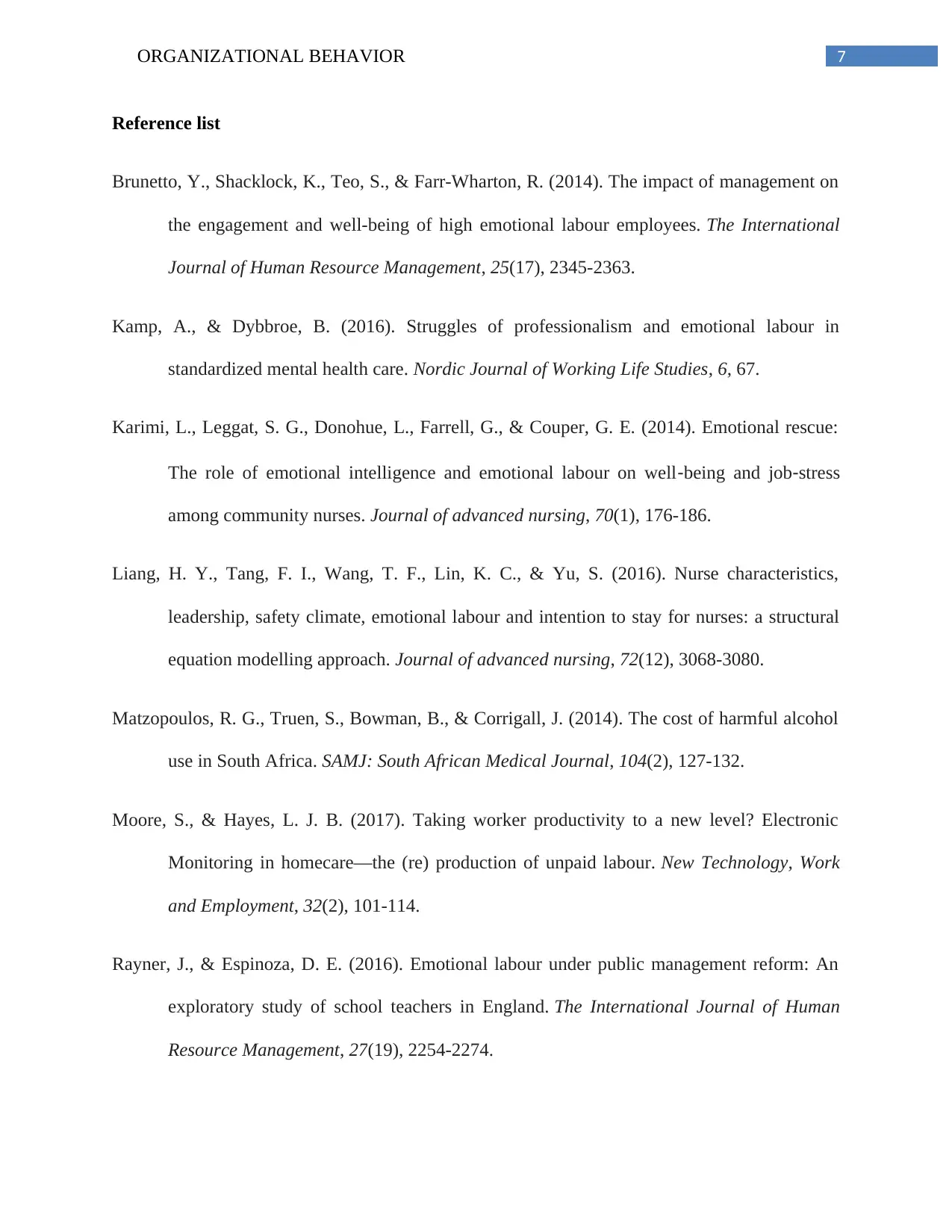
7ORGANIZATIONAL BEHAVIOR
Reference list
Brunetto, Y., Shacklock, K., Teo, S., & Farr-Wharton, R. (2014). The impact of management on
the engagement and well-being of high emotional labour employees. The International
Journal of Human Resource Management, 25(17), 2345-2363.
Kamp, A., & Dybbroe, B. (2016). Struggles of professionalism and emotional labour in
standardized mental health care. Nordic Journal of Working Life Studies, 6, 67.
Karimi, L., Leggat, S. G., Donohue, L., Farrell, G., & Couper, G. E. (2014). Emotional rescue:
The role of emotional intelligence and emotional labour on well‐being and job‐stress
among community nurses. Journal of advanced nursing, 70(1), 176-186.
Liang, H. Y., Tang, F. I., Wang, T. F., Lin, K. C., & Yu, S. (2016). Nurse characteristics,
leadership, safety climate, emotional labour and intention to stay for nurses: a structural
equation modelling approach. Journal of advanced nursing, 72(12), 3068-3080.
Matzopoulos, R. G., Truen, S., Bowman, B., & Corrigall, J. (2014). The cost of harmful alcohol
use in South Africa. SAMJ: South African Medical Journal, 104(2), 127-132.
Moore, S., & Hayes, L. J. B. (2017). Taking worker productivity to a new level? Electronic
Monitoring in homecare—the (re) production of unpaid labour. New Technology, Work
and Employment, 32(2), 101-114.
Rayner, J., & Espinoza, D. E. (2016). Emotional labour under public management reform: An
exploratory study of school teachers in England. The International Journal of Human
Resource Management, 27(19), 2254-2274.
Reference list
Brunetto, Y., Shacklock, K., Teo, S., & Farr-Wharton, R. (2014). The impact of management on
the engagement and well-being of high emotional labour employees. The International
Journal of Human Resource Management, 25(17), 2345-2363.
Kamp, A., & Dybbroe, B. (2016). Struggles of professionalism and emotional labour in
standardized mental health care. Nordic Journal of Working Life Studies, 6, 67.
Karimi, L., Leggat, S. G., Donohue, L., Farrell, G., & Couper, G. E. (2014). Emotional rescue:
The role of emotional intelligence and emotional labour on well‐being and job‐stress
among community nurses. Journal of advanced nursing, 70(1), 176-186.
Liang, H. Y., Tang, F. I., Wang, T. F., Lin, K. C., & Yu, S. (2016). Nurse characteristics,
leadership, safety climate, emotional labour and intention to stay for nurses: a structural
equation modelling approach. Journal of advanced nursing, 72(12), 3068-3080.
Matzopoulos, R. G., Truen, S., Bowman, B., & Corrigall, J. (2014). The cost of harmful alcohol
use in South Africa. SAMJ: South African Medical Journal, 104(2), 127-132.
Moore, S., & Hayes, L. J. B. (2017). Taking worker productivity to a new level? Electronic
Monitoring in homecare—the (re) production of unpaid labour. New Technology, Work
and Employment, 32(2), 101-114.
Rayner, J., & Espinoza, D. E. (2016). Emotional labour under public management reform: An
exploratory study of school teachers in England. The International Journal of Human
Resource Management, 27(19), 2254-2274.
Paraphrase This Document
Need a fresh take? Get an instant paraphrase of this document with our AI Paraphraser
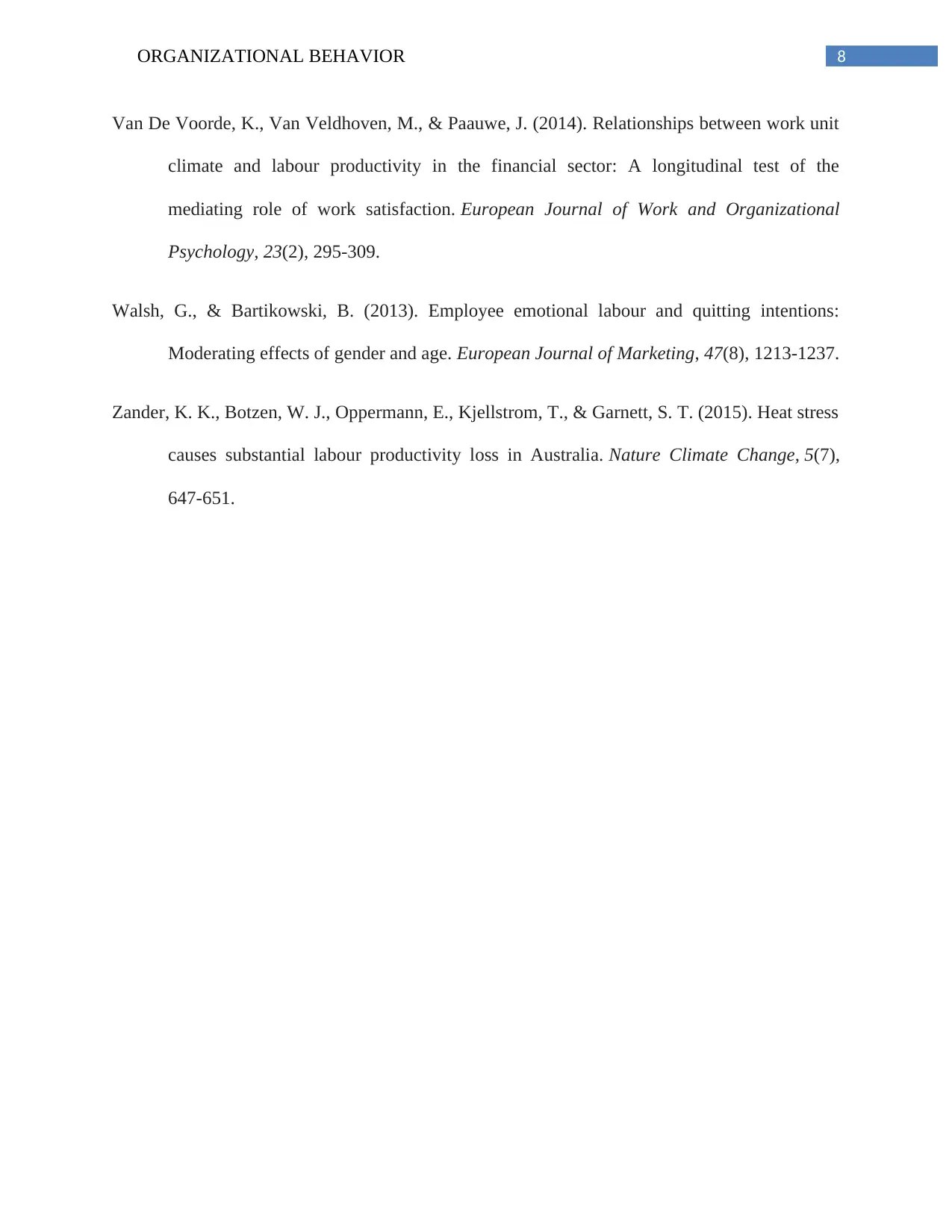
8ORGANIZATIONAL BEHAVIOR
Van De Voorde, K., Van Veldhoven, M., & Paauwe, J. (2014). Relationships between work unit
climate and labour productivity in the financial sector: A longitudinal test of the
mediating role of work satisfaction. European Journal of Work and Organizational
Psychology, 23(2), 295-309.
Walsh, G., & Bartikowski, B. (2013). Employee emotional labour and quitting intentions:
Moderating effects of gender and age. European Journal of Marketing, 47(8), 1213-1237.
Zander, K. K., Botzen, W. J., Oppermann, E., Kjellstrom, T., & Garnett, S. T. (2015). Heat stress
causes substantial labour productivity loss in Australia. Nature Climate Change, 5(7),
647-651.
Van De Voorde, K., Van Veldhoven, M., & Paauwe, J. (2014). Relationships between work unit
climate and labour productivity in the financial sector: A longitudinal test of the
mediating role of work satisfaction. European Journal of Work and Organizational
Psychology, 23(2), 295-309.
Walsh, G., & Bartikowski, B. (2013). Employee emotional labour and quitting intentions:
Moderating effects of gender and age. European Journal of Marketing, 47(8), 1213-1237.
Zander, K. K., Botzen, W. J., Oppermann, E., Kjellstrom, T., & Garnett, S. T. (2015). Heat stress
causes substantial labour productivity loss in Australia. Nature Climate Change, 5(7),
647-651.
1 out of 8
Related Documents
Your All-in-One AI-Powered Toolkit for Academic Success.
+13062052269
info@desklib.com
Available 24*7 on WhatsApp / Email
![[object Object]](/_next/static/media/star-bottom.7253800d.svg)
Unlock your academic potential
Copyright © 2020–2025 A2Z Services. All Rights Reserved. Developed and managed by ZUCOL.





